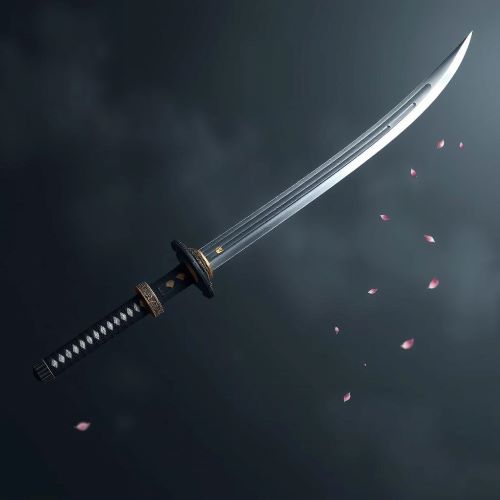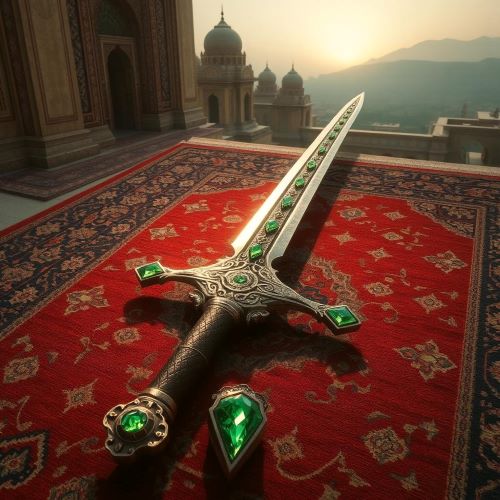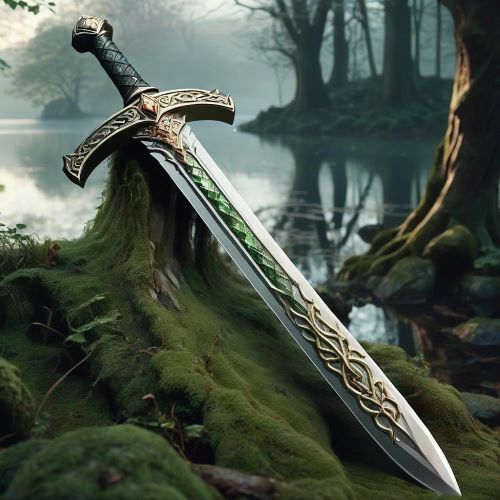Thuan Thien Kiem : The Sword of Haaven
Thuan Thien Kiem
Introduction
Thuan Thien Kiem, often translated as “Heaven’s Will Sword,” is among the most revered symbols in Vietnamese mythology and history. This legendary weapon is intrinsically linked with the national hero King Lê Lợi and the struggle for Vietnam’s independence from the Ming dynasty in the 15th century. More than a tool of war, Thuan Thien Kiem represents a divine mandate, a celestial endorsement of rightful leadership, and the spiritual essence of the Vietnamese people’s enduring spirit. Its story continues to be a cornerstone of Vietnamese folklore, capturing imaginations and reinforcing the belief in destiny and righteousness.
Origins
The origins of Thuan Thien Kiem are steeped in mysticism and destiny. According to legend, the blade was first discovered by a humble fisherman named Lê Thận who repeatedly found the same mysterious object entangled in his fishing net. Eventually, it was revealed to be a sword blade engraved with the phrase “Thuận Thiên”—meaning “In Accord with Heaven.” This was seen as a sign that a greater purpose was at hand.
Years later, Lê Lợi, then a resistance leader, encountered a glowing sword hilt lodged in an ancient tree. When he brought the hilt to Lê Thận, it seamlessly united with the blade, symbolizing the heavens’ approval of Lê Lợi’s mission. This moment signified more than just the discovery of a magical weapon—it marked the rise of a leader whose path was divinely guided. This extraordinary finding occurred just as the Vietnamese were seeking liberation, reinforcing the notion that the sword was gifted by divine forces such as the Dragon King or the Golden Turtle God, further connecting the legend with Vietnam’s rich pantheon of mythological beings.
Think you know your myths and legends? Dive into the world of ancient stories and test your knowledge with our engaging quizzes on Mythlok!
Powers
The sword Thuan Thien Kiem was believed to hold incredible supernatural powers that went far beyond physical might. Once in possession of the sword, Lê Lợi was said to undergo a striking transformation. His stature increased, and his strength surpassed that of ordinary men, giving him a commanding presence on the battlefield. This divine augmentation of his abilities served to inspire loyalty among his followers and fear among his enemies.
The sword also emitted an ethereal glow when unsheathed, often described as radiant or even blinding, which was interpreted as a sign of heavenly favor. The very words etched on the blade—“Thuận Thiên”—infused every swing with symbolic power, reminding those who followed Lê Lợi that their cause was not merely political or military but sanctioned by a higher power. These qualities made the sword a potent weapon in both physical and psychological warfare, strengthening morale and unifying the resistance.
Owners/Users
Lê Lợi is the central figure associated with Thuan Thien Kiem, both as its wielder and as the chosen leader of Vietnam’s liberation. Before ascending to the throne, he was a guerrilla leader, but the acquisition of the sword marked a turning point in his destiny. The weapon came to embody his right to rule, representing both authority and responsibility bestowed by divine will.
Although the fisherman Lê Thận played a role in the sword’s discovery, he never wielded it in battle. His part in the legend remains significant as a facilitator of fate, while the actual use and symbolic ownership remained solely with Lê Lợi. No records or myths speak of the sword passing into other mortal hands after its divine mission was complete, reinforcing its exclusivity and sacred nature.
Instances used
The most important use of Thuan Thien Kiem was during the Lam Sơn uprising, which lasted from 1418 to 1428. The sword was present during pivotal battles that turned the tide against the Ming forces. With the sword in hand, Lê Lợi led campaigns that not only reclaimed Vietnamese territory but also rekindled national identity. It served as a constant reminder that his cause aligned with the will of Heaven, and this belief empowered his army and rallied the nation.
After the victory and the establishment of the Lê dynasty, the sword’s journey did not end with conquest. One of the most famous legends surrounding Thuan Thien Kiem occurred after peace was restored. As Lê Lợi was boating on a lake in Hanoi, the Golden Turtle God (Kim Quy) surfaced and asked for the return of the sword to its celestial origins. Recognizing that his divine mission had been fulfilled, Lê Lợi returned the sword, and the lake was renamed Hoàn Kiếm, or “Lake of the Returned Sword.” This moment marked the completion of a sacred cycle—borrowing divine power for justice, then surrendering it back once harmony was restored.
Today, Hoàn Kiếm Lake remains a powerful national symbol and a testament to this legend, drawing both locals and visitors who continue to be inspired by the story of the sword and the man who wielded it.
Frequently Asked Questions
Lorem ipsum dolor sit amet, consectetur adipiscing?
Lorem ipsum dolor sit amet, consectetur adipiscing elit. Praesent convallis vestibulum justo, ac tincidunt nunc vehicula quis. Nullam id dolor quis orci malesuada feugiat. Curabitur aliquet libero at urna ullamcorper, ac ultricies nulla dapibus.
Lorem ipsum dolor sit amet, consectetur adipiscing?
Lorem ipsum dolor sit amet, consectetur adipiscing elit. Praesent convallis vestibulum justo, ac tincidunt nunc vehicula quis. Nullam id dolor quis orci malesuada feugiat. Curabitur aliquet libero at urna ullamcorper, ac ultricies nulla dapibus.
Lorem ipsum dolor sit amet, consectetur adipiscing?
Lorem ipsum dolor sit amet, consectetur adipiscing elit. Praesent convallis vestibulum justo, ac tincidunt nunc vehicula quis. Nullam id dolor quis orci malesuada feugiat. Curabitur aliquet libero at urna ullamcorper, ac ultricies nulla dapibus.
Lorem ipsum dolor sit amet, consectetur adipiscing?
Lorem ipsum dolor sit amet, consectetur adipiscing elit. Praesent convallis vestibulum justo, ac tincidunt nunc vehicula quis. Nullam id dolor quis orci malesuada feugiat. Curabitur aliquet libero at urna ullamcorper, ac ultricies nulla dapibus.
Lorem ipsum dolor sit amet, consectetur adipiscing?
Lorem ipsum dolor sit amet, consectetur adipiscing elit. Praesent convallis vestibulum justo, ac tincidunt nunc vehicula quis. Nullam id dolor quis orci malesuada feugiat. Curabitur aliquet libero at urna ullamcorper, ac ultricies nulla dapibus.
Watch
Source
Battle Blades. (n.d.). Thuận Thiên Sword: Myth and Might in Lê Lợi’s Hands. Retrieved from https://battleblades.fun/thuan-thien-sword/
Wikipedia contributors. (n.d.). Thuận Thiên (sword). Wikipedia. Retrieved from https://en.wikipedia.org/wiki/Thu%E1%BA%ADn_Thi%C3%AAn_(sword)
Wikipedia contributors. (n.d.). Thuận Thiên Kiếm – Wikipedia tiếng Việt. Retrieved from https://vi.wikipedia.org/wiki/Thu%E1%BA%ADn_Thi%C3%AAn_Ki%E1%BA%BFm
Vietnamese Wiki. (n.d.). Thuận Thiên. Retrieved from https://vietnamese.fandom.com/wiki/Thu%E1%BA%ADn_Thi%C3%AAn
Journey From The Fall. (n.d.). Legend. Retrieved from http://journeyfromthefall.com/Legend.aspx
The White Dragon Temple. (n.d.). Thuận Thiên 「タンキエム」. Retrieved from http://ddon.wikidot.com/weapons:thuanthien
Znews.vn. (n.d.). Thuận Thiên Kiếm: truyền thuyết gươm thần. Retrieved from https://znews.vn/thuan-thien-kiem-truyen-thuyet-guom-than-post25797.html
IRIS NGUYEN. (2020, June 1). The Sword Thuan Thien in Vietnamese Mythology…. Retrieved from https://irisnguyen9.wordpress.com/2020/06/01/the-sword-thuan-thien-in-vietnamese-mythology/









